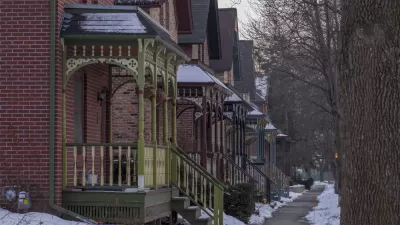Waterfront views and large parcels of vacant land should be a good urban revitalization in a growing city like Philadelphia, but the Central Delaware waterfront has fallen short of expectations.
Inga Saffron reviews the goals and results of a master plan approved in 2011 to remake the Central Delaware waterfront in Philadelphia.
The key approach of this plan, according to Saffron, was to aim for something different than the skyscraper-lined model of Vancouver and Miami.
By spacing out those smaller buildings, the thinking went, the city would create the beginnings of a true urban streetscape along Delaware Avenue. The mid-rises would populate the river, bringing just enough people to Delaware Avenue to support retail and justify adding a trolley line. The waterfront’s zoning was adjusted to make it easy to erect buildings under 25 stories, using a category called CMX-3.
While that seemed like a sound strategy at the time, Saffron makes the case that the results in 2019 have fallen far short of the ambitions described in 2011.
"Only one mid-rise has gone up over the last decade: PMC’s 16-story One Water Street, next to the Ben Franklin Bridge. Virtually every other residential project has been townhouses," reports Saffron. The maximum extent of the building envelope has not been realized, and the city is falling short of its vision for a "walkable, mixed-use riverfront neighborhood."
Saffron digs into more detail about why the townhomes that have been developed since 2011 fall short of the vision established by the Master Plan for the Central Delaware. There's even the development of a cap park to consider (work started in 2018), but even that hasn't convinced developers of adjacent projects to ditch to townhome development scheme.

Trump Administration Could Effectively End Housing Voucher Program
Federal officials are eyeing major cuts to the Section 8 program that helps millions of low-income households pay rent.

Planetizen Federal Action Tracker
A weekly monitor of how Trump’s orders and actions are impacting planners and planning in America.

Ken Jennings Launches Transit Web Series
The Jeopardy champ wants you to ride public transit.

Washington Legislature Passes Rent Increase Cap
A bill that caps rent increases at 7 percent plus inflation is headed to the governor’s desk.

From Planning to Action: How LA County Is Rethinking Climate Resilience
Chief Sustainability Officer Rita Kampalath outlines the County’s shift from planning to implementation in its climate resilience efforts, emphasizing cross-departmental coordination, updated recovery strategies, and the need for flexible funding.

New Mexico Aging Department Commits to Helping Seniors Age ‘In Place’ and ‘Autonomously’ in New Draft Plan
As New Mexico’s population of seniors continues to grow, the state’s aging department is proposing expanded initiatives to help seniors maintain their autonomy while also supporting family caregivers.
Urban Design for Planners 1: Software Tools
This six-course series explores essential urban design concepts using open source software and equips planners with the tools they need to participate fully in the urban design process.
Planning for Universal Design
Learn the tools for implementing Universal Design in planning regulations.
Heyer Gruel & Associates PA
Ada County Highway District
Institute for Housing and Urban Development Studies (IHS)
City of Grandview
Harvard GSD Executive Education
Toledo-Lucas County Plan Commissions
Salt Lake City
NYU Wagner Graduate School of Public Service





























